Overview
This article outlines nine best practices for CFOs aimed at effectively managing project stakeholders. It underscores the critical importance of tailored engagement strategies designed to enhance communication and align stakeholder interests with overarching business objectives. Moreover, it illustrates how systematic approaches—such as stakeholder mapping and regular updates—can lead to improved project outcomes and significantly higher satisfaction rates among participants. Consequently, these practices ultimately foster sustainable growth.
Introduction
Navigating the complex landscape of project stakeholder management is a critical endeavor for CFOs, particularly in small and medium enterprises (SMEs) where unique challenges abound. This article delves into nine best practices that not only enhance stakeholder engagement but also drive project success by aligning interests and fostering collaboration. Moreover, as organizations strive for effective communication and involvement, the question remains: how can CFOs implement these strategies to overcome potential pitfalls and ensure that every voice is heard in the decision-making process?
Transform Your Small/ Medium Business: Tailored Consulting for Stakeholder Engagement
Small and medium enterprises (SMEs) encounter distinctive challenges that necessitate specialized consulting services to implement project stakeholder management best practices for effective engagement with stakeholders. At Transform Your Small/Medium Business, we deliver tailored consulting that prioritizes an understanding of the unique requirements and expectations of each interest group. Our comprehensive turnaround and restructuring consulting services encompass:
- Financial assessment
- Interim management
- Operational efficiency
These services empower businesses to devise strategies that foster stronger relationships. By executing thorough business reviews and leveraging advanced tools such as surveys and real-time analytics, organizations can adopt project stakeholder management best practices to ensure stakeholders feel valued and heard, thereby enhancing communication and aligning stakeholder interests with business objectives. This alignment is essential for achieving improved project outcomes and promoting sustainable growth.
For instance, a retail company undergoing reorganization can significantly benefit from our consulting services that prioritize interaction with suppliers, customers, and employees. By addressing their concerns during the transition, the business not only mitigates potential disruptions but also fortifies its relationships with stakeholders, paving the way for a more resilient operational framework. As Sarah Wilkin aptly states, "sustainability is simply doing the right thing - in terms of your business, your people, the environment and wider society." This perspective underscores the importance of effective participant involvement in achieving broader sustainability objectives.
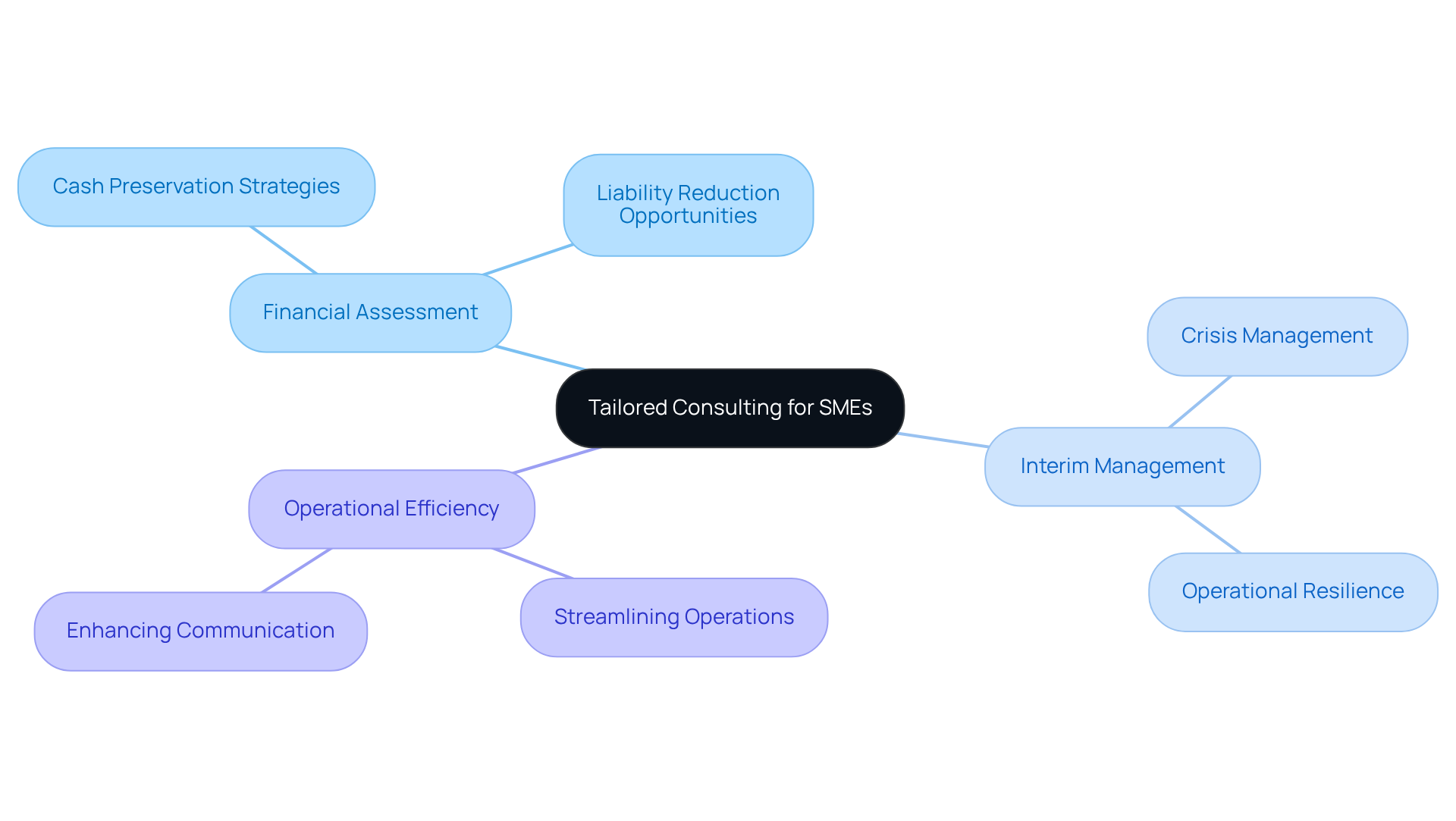
BrightWork: Streamlined Tools for Effective Stakeholder Engagement
BrightWork provides a comprehensive suite of tools designed to significantly enhance participant engagement processes. These tools empower managers with real-time insights into status, facilitating effective communication of updates in line with project stakeholder management best practices. Features such as dashboards and reporting tools enable involved parties to easily access pertinent information, eliminating the need for frequent follow-ups. This proactive strategy ensures that all parties remain informed and engaged, thereby minimizing misunderstandings and fostering a collaborative environment.
Utilizing BrightWork's dashboards is essential for implementing project stakeholder management best practices, allowing managers to seamlessly share progress reports with stakeholders, promoting transparency and building trust. This level of engagement is crucial, as organizations adept at managing interests experience a 20% increase in customer satisfaction and a 35% boost in employee participation. Furthermore, implementing project stakeholder management best practices through effective communication with stakeholders via technology not only enhances outcomes but also mitigates risks, leading to a 40% reduction in delays. The incorporation of real-time analytics facilitates continuous monitoring of business performance, enabling teams to make informed decisions swiftly and adjust strategies as necessary.
To reap these benefits, organizations must establish clear, measurable KPIs for participant involvement and provide adequate training and support for the successful utilization of management tools. Additionally, managers should be cognizant of the potential challenges associated with collaborating with diverse parties to ensure effective participation.
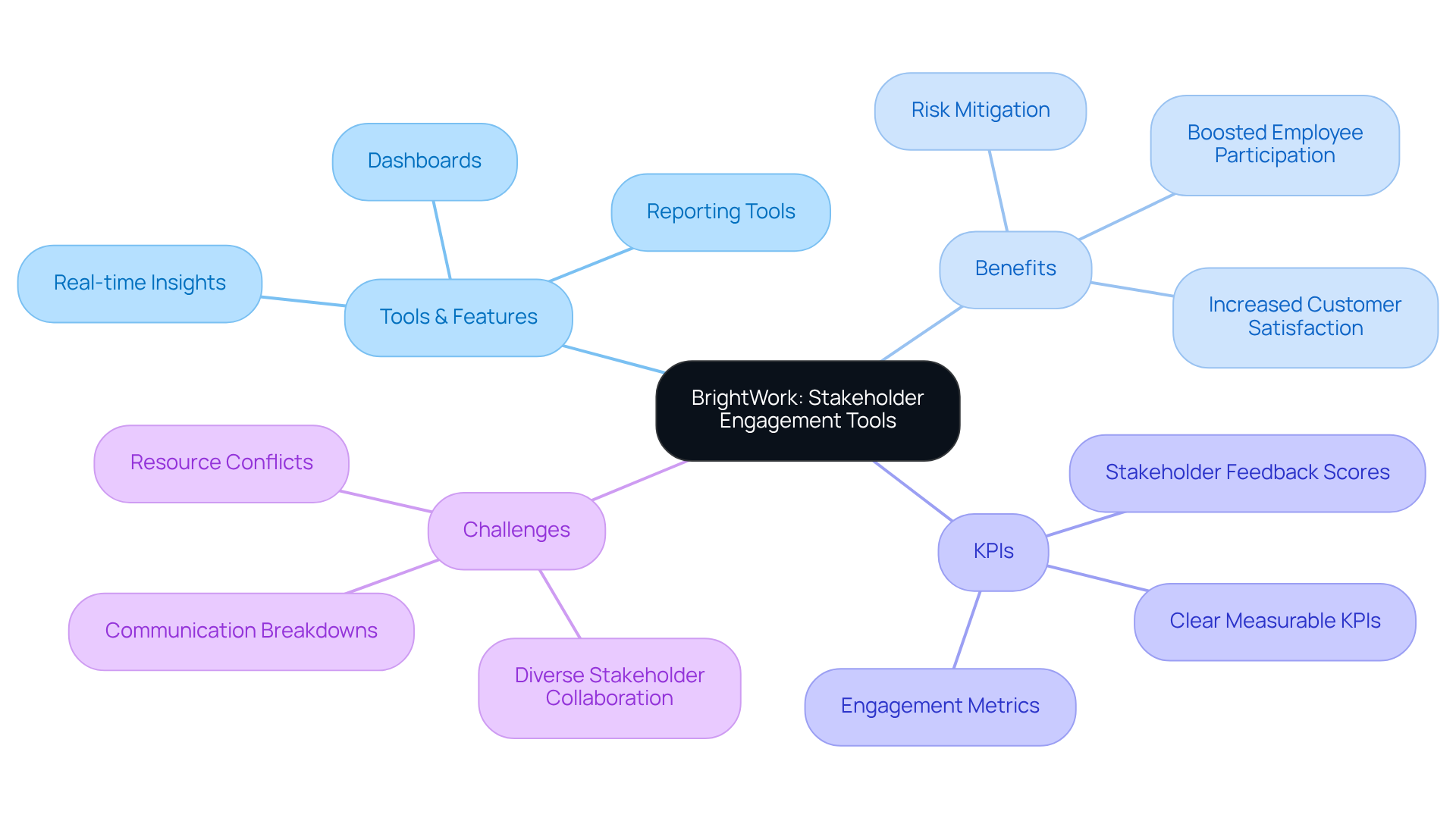
Float.com: Comprehensive Strategies for Stakeholder Management
The success of any initiative relies on effective project stakeholder management best practices. It begins with the identification and analysis of all pertinent participants. Employing mapping tools enables businesses to classify interested parties according to their influence and engagement, thereby aiding in the development of project stakeholder management best practices. This organized method guarantees that project stakeholder management best practices are followed, ensuring that key influencers receive the necessary focus, ultimately enhancing results.
For instance, in building endeavors, involving local community participants through focused communication can address their concerns and foster goodwill, leading to smoother execution. Statistics indicate that organizations that apply project stakeholder management best practices experience a 78% success rate in initiatives, in contrast to just 40% for those with lower involvement. Furthermore, companies that implement project stakeholder management best practices by incorporating input from interested parties into product development experience a 30% higher adoption rate. By emphasizing interest group mapping and tackling issues like information silos, companies can significantly enhance their project stakeholder management best practices and overall business performance. As Joshna Dsouza highlights, ensuring clarity, accuracy, and practical relevance in participant engagement is essential for achieving successful outcomes.
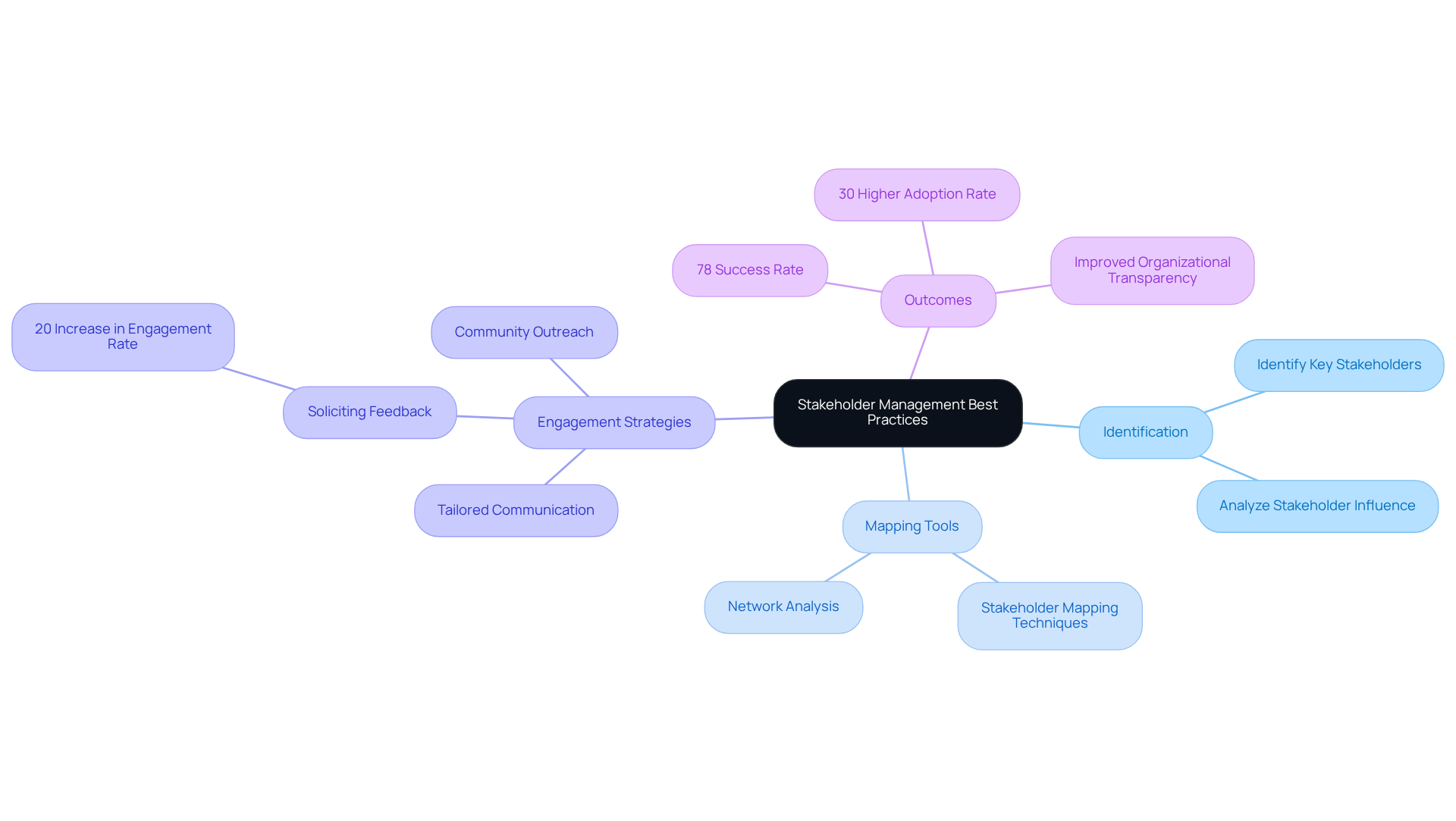
PMI.org: Essential Resources for Stakeholder Analysis and Management
PMI.org stands as a vital resource for interest group analysis and management, delivering a comprehensive suite of guidelines, templates, and best practices specifically designed for CFOs and project managers. By leveraging these resources, organizations can establish a systematic approach to project stakeholder management best practices, ensuring that diverse perspectives are integrated into their decision-making processes.
Moreover, PMI's party management templates facilitate the development of a participant involvement plan, delineating communication strategies and engagement activities tailored for various group types. This structured methodology not only enhances participant engagement but also aligns with project stakeholder management best practices, significantly impacting the success rates of initiatives. Research indicates that initiatives characterized by effective participant management are 2.5 times more likely to succeed, underscoring the critical role of proactive involvement in achieving organizational objectives.
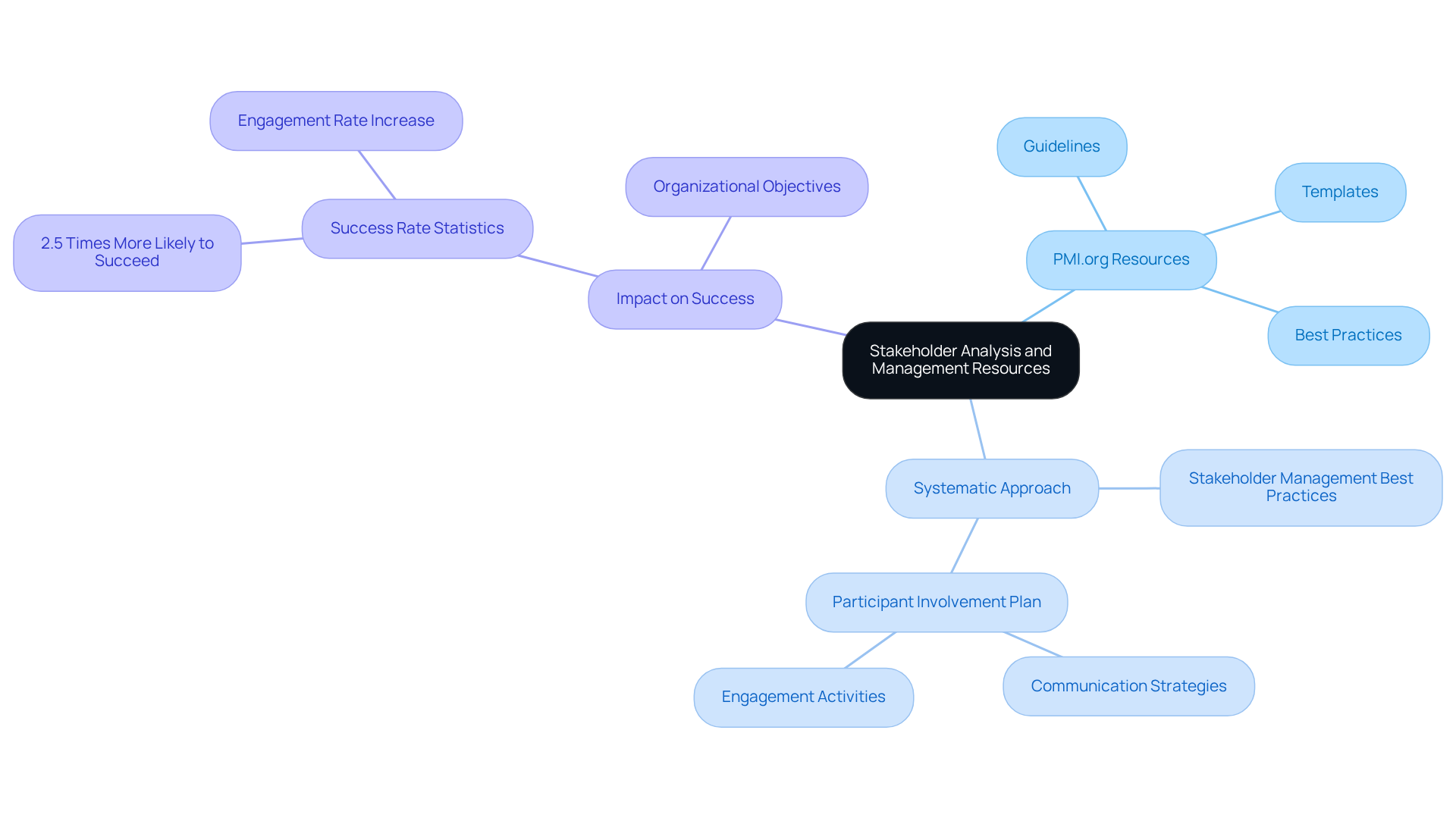
Holistic Training: Best Practices for Successful Stakeholder Management
Holistic training programs are crucial for the effective management of involved parties, focusing on project stakeholder management best practices that prioritize communication, empathy, and active listening. These training sessions encompass essential topics such as participant identification, engagement strategies, and conflict resolution techniques. By investing in such training, organizations empower their teams to forge stronger connections with interested parties, significantly enhancing project success rates.
For instance, incorporating role-playing activities into training programs can simulate real-world interactions with involved parties. This practical approach enables participants to refine their interpersonal skills within a controlled environment, fostering both confidence and competence in managing various interactions. Furthermore, evaluating key individuals and their spheres of influence is vital, as it allows teams to tailor their interactions and strategies effectively.
Statistics reveal that organizations prioritizing communication training experience a notable improvement in relationships with interested parties, with successful involvement strategies yielding a 15% increase in outcomes. Significantly, 40% of respondents identified managing interested parties as the single most critical process for project success, underscoring the importance of these training programs.
Current trends in participant management training highlight the integration of technology and data analysis to assess involvement levels, ensuring that training remains relevant and effective. However, organizations must also recognize the challenges associated with measuring involvement from interested parties, as various communication channels can complicate this process. By embracing project stakeholder management best practices, organizations can effectively navigate the complexities of interest group management and achieve sustainable project success.
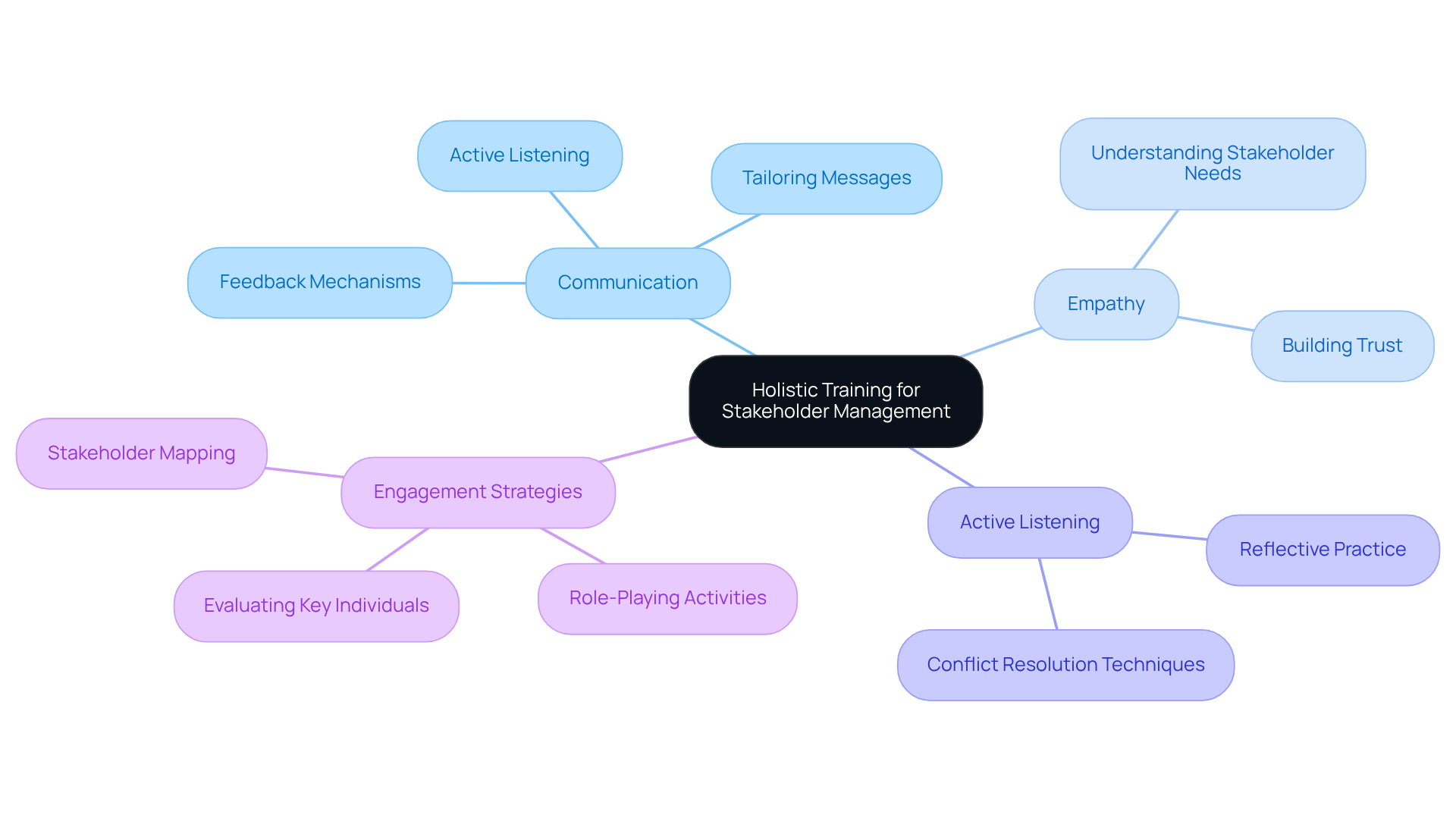
Leadership Pipeline Institute: Structured Approaches to Stakeholder Management
The Leadership Pipeline Institute underscores the critical role of project stakeholder management best practices for effectively managing interested parties in alignment with organizational objectives. By embracing a systematic framework that incorporates project stakeholder management best practices, organizations can guarantee consistent and effective interactions with stakeholders. This process initiates with a comprehensive business assessment aimed at identifying essential participants, analyzing their needs, and applying project stakeholder management best practices to formulate tailored engagement strategies that foster collaboration and support.
For instance, regular participant meetings significantly enhance outcomes by facilitating open dialogue and gathering valuable feedback. Such interactions not only keep stakeholders informed but also cultivate a sense of appreciation throughout the initiative's lifecycle. Moreover, the incorporation of a client dashboard for real-time business analytics empowers organizations to continuously monitor performance and adjust strategies as necessary, thereby enhancing decision-making processes. Data reveals that 63% of firms implementing an engagement strategy report improved performance outcomes, underscoring the importance of project stakeholder management best practices in achieving organizational success.
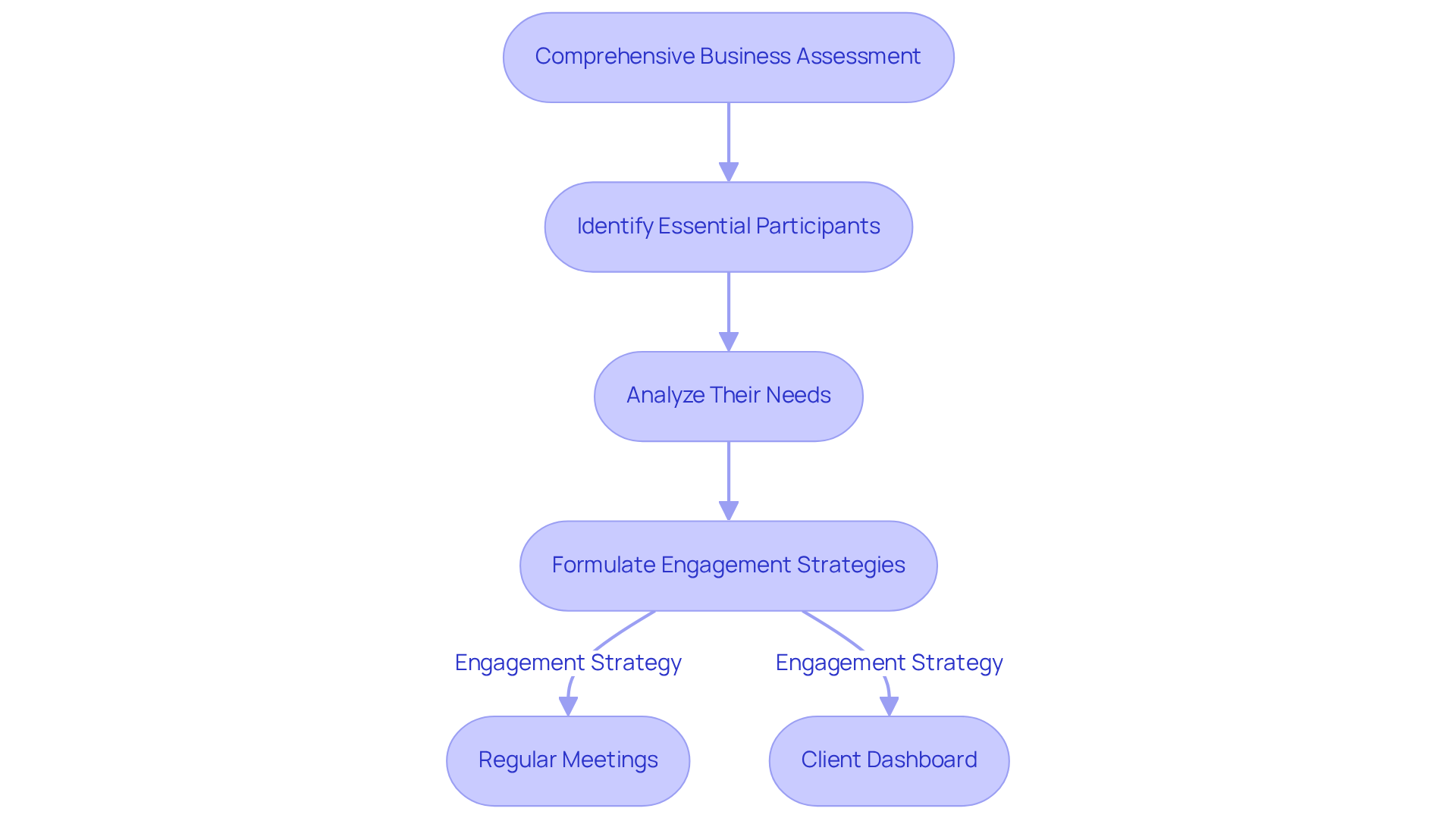
Mural.co: Practical Tips for Managing Stakeholder Expectations
Efficient handling of participant expectations is essential for achieving successful results. Key strategies that align with project stakeholder management best practices include:
- Setting clear expectations from the outset
- Encouraging open dialogue
- Providing regular updates on project progress
Proactively managing these expectations not only helps prevent misunderstandings but also fosters trust among all involved parties.
A clearly outlined strategy for information sharing, in line with project stakeholder management best practices, is crucial; it specifies how and when interested parties will receive updates, ensuring alignment and minimizing unexpected events. For instance, following up after meetings with a summary of meeting notes and action items is vital to ensure that participants understand their responsibilities and next steps. Moreover, a strategy for information exchange should incorporate:
- Scheduled status updates
- Milestone alerts
- Feedback meetings
These elements are all part of project stakeholder management best practices, collectively enhancing participant satisfaction and involvement. Research indicates that organizations with structured communication strategies experience higher levels of satisfaction among interested parties, as transparency and consistency in updates cultivate a collaborative environment. By implementing these strategies, organizations can effectively navigate relationships with interested parties and drive project success by adhering to project stakeholder management best practices.
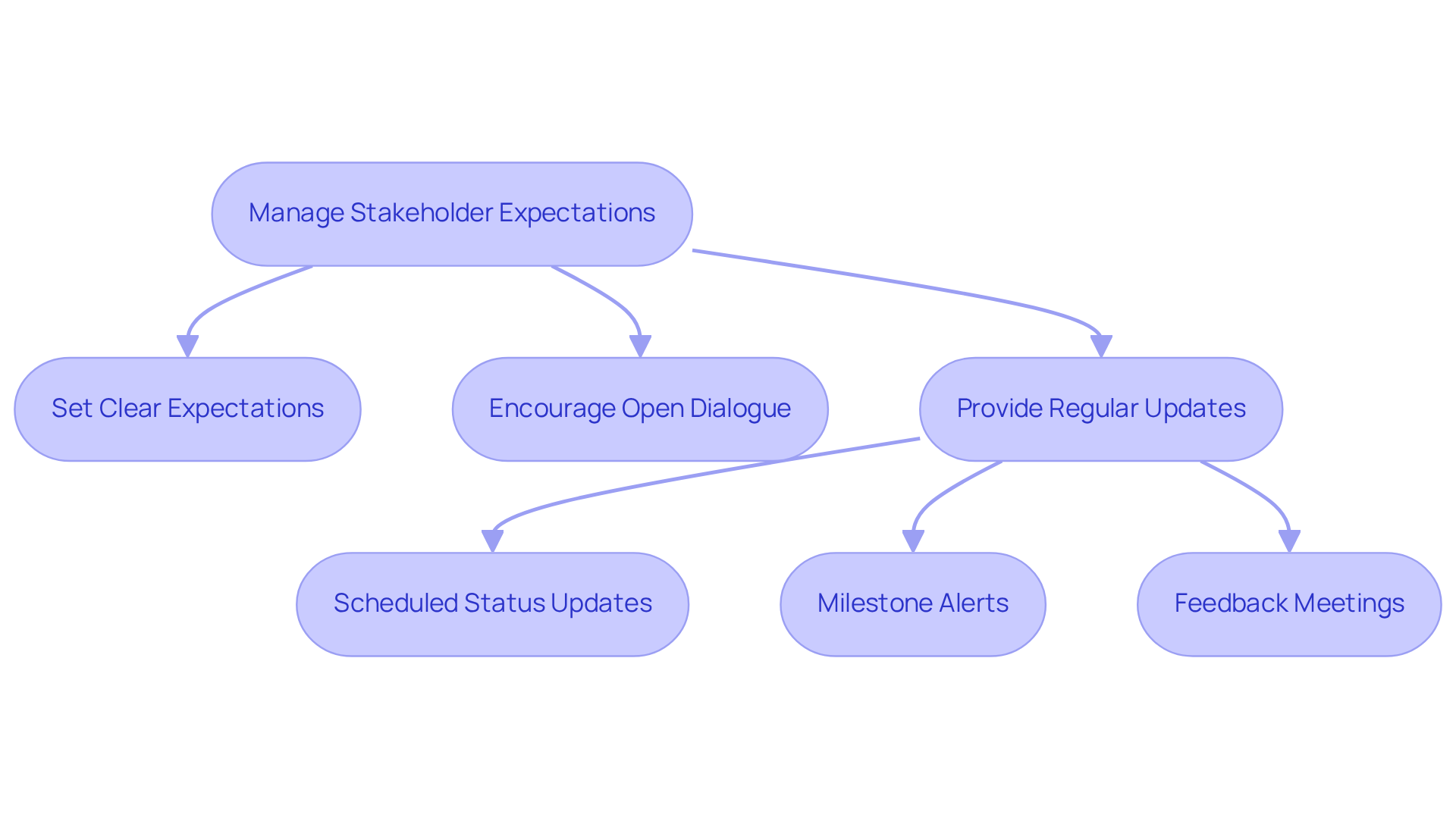
ResearchGate: Academic Insights on Stakeholder Management Strategies
ResearchGate serves as a vital resource for accessing academic insights into interest group management strategies. By examining academic articles and research papers, organizations can enhance their understanding of project stakeholder management best practices based on empirical evidence.
Research indicates that organizations emphasizing participant engagement in decision-making processes can significantly improve their outcomes, with elevated involvement rates linked to alignment between participant interests and organizational goals. Moreover, empirical evidence highlights that active participant involvement in project stakeholder management best practices nurtures trust and loyalty, creating a collective sense of purpose that leads to competitive advantages.
As emphasized by researchers, incorporating various participants into project stakeholder management best practices is essential for addressing the needs of vulnerable groups and ensuring sustainable outcomes. This approach not only mitigates risks but also unveils opportunities for innovation and growth, reinforcing the importance of adopting inclusive engagement strategies.
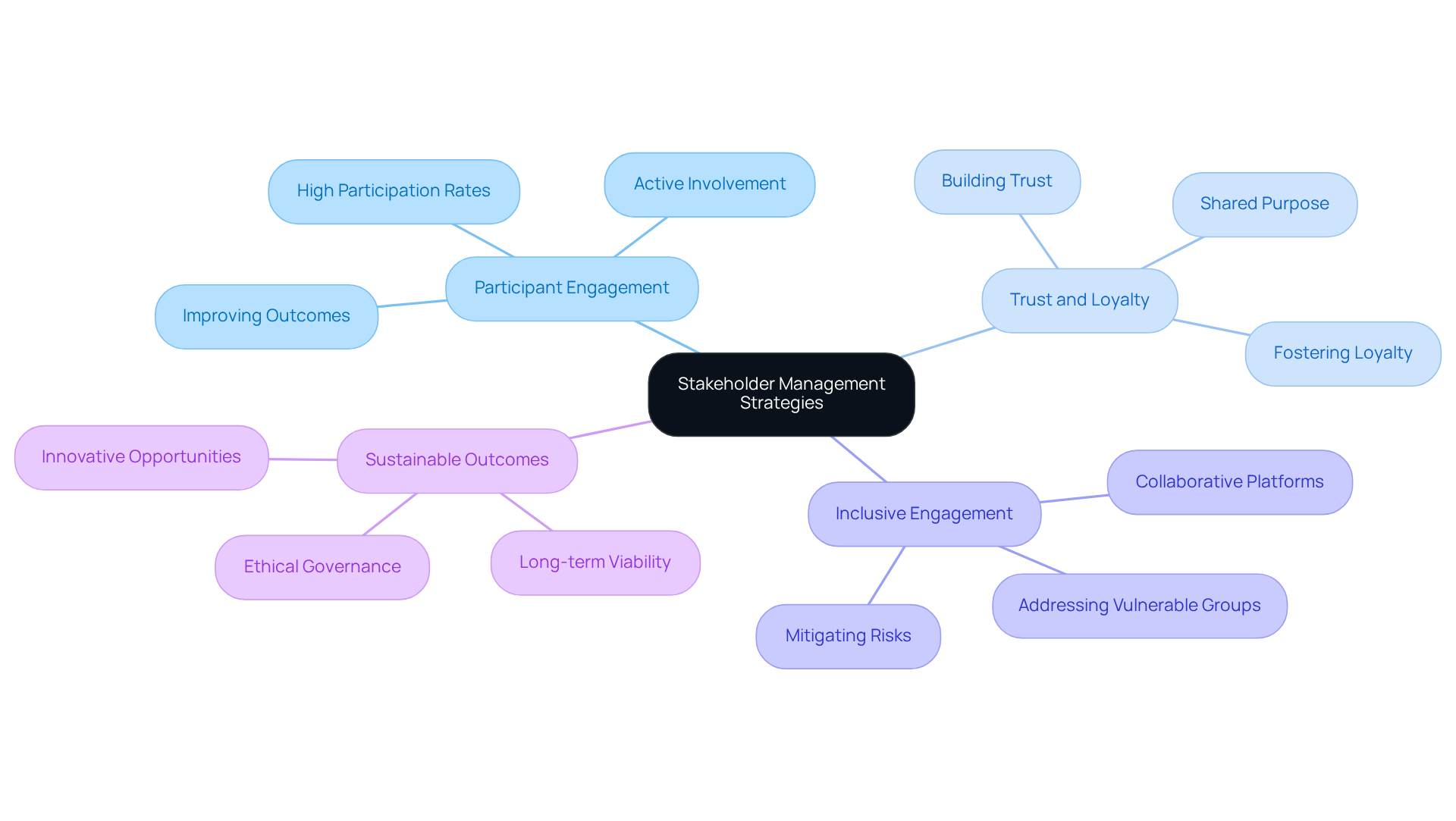
Simply Stakeholders: Effective Communication Strategies for Engagement
Simply Stakeholders highlights the crucial role of project stakeholder management best practices in effectively engaging interested parties through efficient messaging techniques. Key strategies that align with project stakeholder management best practices include:
- Recognizing the needs of stakeholders
- Selecting appropriate information exchange channels
- Encouraging responses through methods such as surveys and questionnaires
By fostering transparent dialogue, organizations can apply project stakeholder management best practices to build trust and ensure that participants feel valued and involved in the initiative.
Regular feedback sessions serve as an essential tool for assessing participant satisfaction and swiftly addressing concerns, which are part of project stakeholder management best practices. Research indicates that project stakeholder management best practices, which include active participant involvement, lead to a success rate of 78%, compared to only 40% for initiatives with minimal engagement. This statistic highlights the critical importance of involving interested parties in project stakeholder management best practices and emphasizes that companies engaging these groups are 50% more likely to meet their significant objectives. For example, a software company that implemented structured feedback meetings achieved a Net Promoter Score of +70, reflecting high customer satisfaction and loyalty.
Moreover, experts emphasize that promoting open dialogue is one of the project stakeholder management best practices that can significantly enhance participant engagement. As Angela Rodgers noted, "Tapping into the viewpoints of interested parties can influence your decision-making, reduce risk, prevent costly issues, establish trust, and foster more sustainable outcomes." This statement illustrates the transformative power of effective communication in the context of project stakeholder management best practices, ultimately leading to improved performance and lasting success. Furthermore, initiating every client interaction with a comprehensive business assessment enables organizations to implement project stakeholder management best practices, aligning essential participants and better understanding their needs, fostering a more strategic approach to tackling challenges and leveraging strengths.
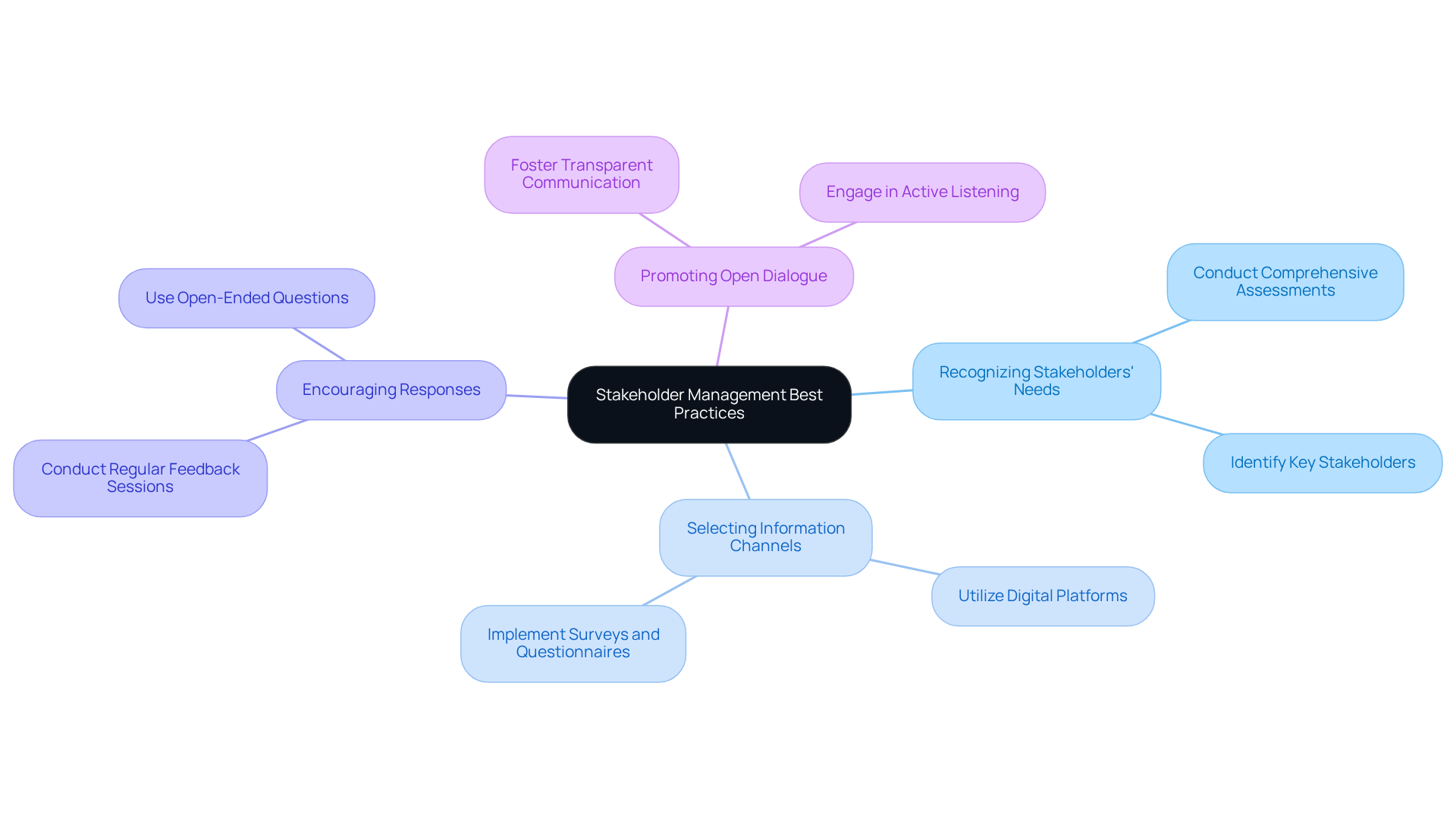
Sunscrapers: Best Practices for Stakeholder Communication in Projects
Sunscrapers delineates optimal strategies that align with project stakeholder management best practices for engaging parties essential for achieving success. These practices encompass setting clear objectives for dialogue, ensuring transparency, and actively listening to input from interested parties. By implementing project stakeholder management best practices, organizations can enhance participant involvement and ensure alignment with objectives.
For instance, developing a participant information strategy that outlines how details will be exchanged is essential in project stakeholder management best practices, as it aids in avoiding misunderstandings and keeps contributors informed throughout the project lifecycle. Furthermore, collecting employee input is vital for efficient internal interaction, as it fosters a sense of inclusion and ensures that participants feel acknowledged and valued.
Data indicates that 93% of interactions are nonverbal, underscoring the importance of understanding nonverbal signals in dealings with interested parties. Additionally, nearly 80% of program managers assert that project stakeholder management best practices are crucial for business success, highlighting the necessity for robust strategies that align with objectives.
Current trends reveal a shift towards leveraging technology to enhance stakeholder interaction. Tools that facilitate real-time updates and feedback loops are increasingly popular, enabling more dynamic interactions. Moreover, almost 80% of managers overseeing initiatives believe AI is poised to significantly transform their roles, emphasizing the growing influence of technology on management practices. By prioritizing these communication strategies, organizations can cultivate a collaborative environment that propels project success and aligns all parties with the project stakeholder management best practices.
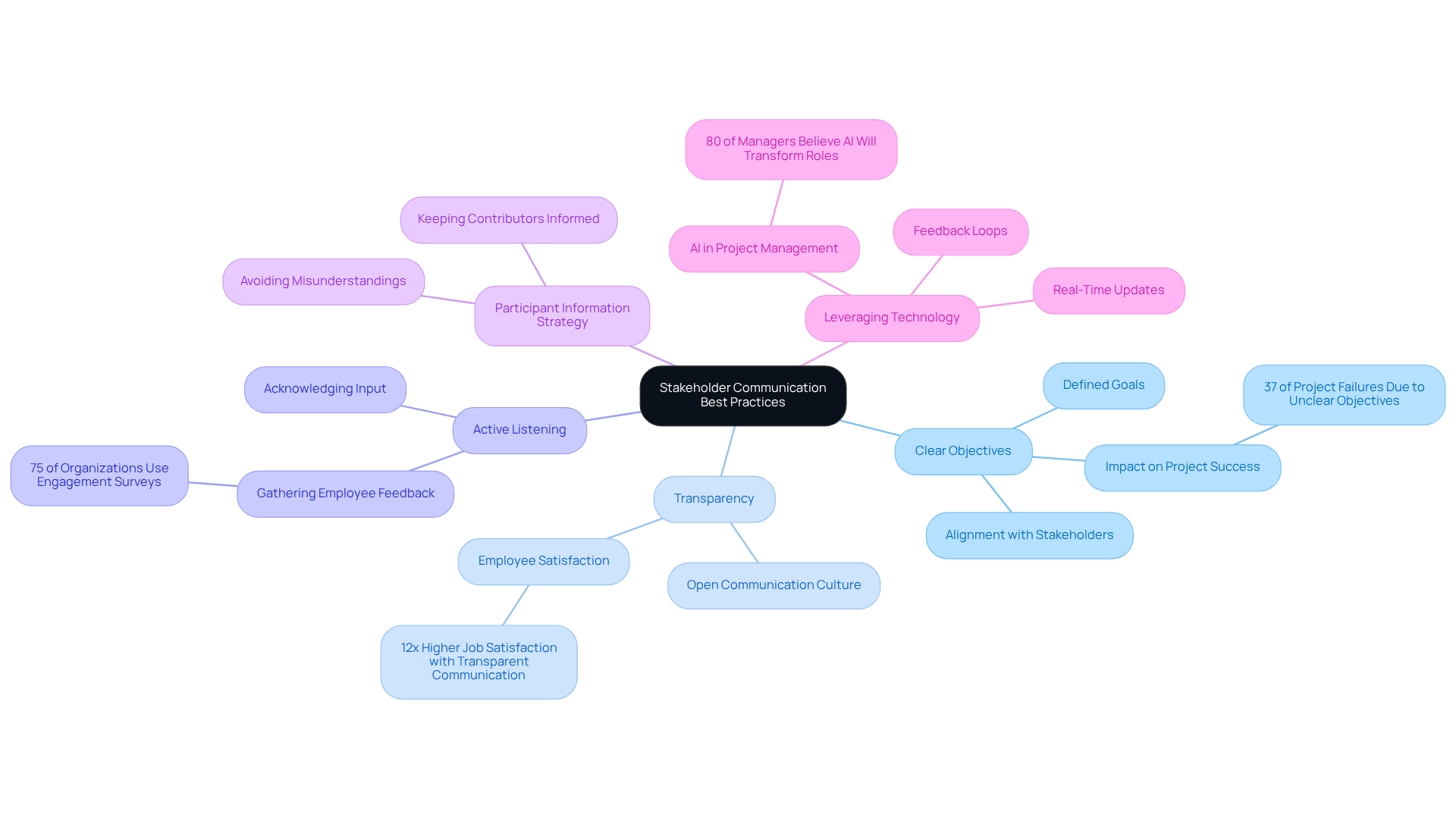
Conclusion
Effective project stakeholder management is paramount for CFOs aiming to align organizational objectives with stakeholder expectations. By implementing best practices tailored for diverse interest groups, businesses can cultivate stronger relationships, enhance communication, and ultimately drive project success. The insights presented throughout this article underscore the significance of adopting a structured approach to stakeholder engagement, ensuring that all parties feel valued and heard.
Key arguments highlight the importance of utilizing:
- Specialized consulting services
- Advanced tools
- Comprehensive training programs
to foster effective stakeholder interaction. From employing real-time analytics for informed decision-making to leveraging communication strategies that promote transparency, organizations can significantly improve their project outcomes. The statistics presented, such as the 78% success rate for initiatives with high stakeholder involvement, further reinforce the necessity of integrating stakeholder management best practices into business operations.
In light of these insights, organizations are encouraged to prioritize stakeholder engagement as a critical component of their strategic framework. By embracing the outlined best practices and continually seeking innovative methods for communication and involvement, CFOs can not only mitigate risks but also unlock opportunities for growth and sustainability. The journey towards effective stakeholder management is ongoing, and the commitment to fostering these relationships will undoubtedly pave the way for long-term success.
Frequently Asked Questions
What challenges do small and medium enterprises (SMEs) face regarding stakeholder engagement?
SMEs encounter distinctive challenges that require specialized consulting services to implement project stakeholder management best practices for effective engagement with stakeholders.
What consulting services does Transform Your Small/Medium Business offer?
The consulting services include financial assessment, interim management, and operational efficiency, which help businesses develop strategies for stronger stakeholder relationships.
How do comprehensive business reviews and advanced tools assist in stakeholder engagement?
Comprehensive business reviews and tools like surveys and real-time analytics help organizations adopt project stakeholder management best practices, ensuring stakeholders feel valued and enhancing communication.
Can you provide an example of how consulting services benefit a business?
A retail company undergoing reorganization can benefit by addressing concerns of suppliers, customers, and employees during the transition, which helps mitigate disruptions and strengthen stakeholder relationships.
What is the significance of effective participant involvement in business sustainability?
Effective participant involvement is crucial for achieving broader sustainability objectives, as it aligns stakeholder interests with business goals, leading to improved project outcomes.
What tools does BrightWork provide for stakeholder engagement?
BrightWork offers a suite of tools, including dashboards and reporting tools, that enhance participant engagement processes by providing real-time insights and facilitating effective communication.
How does using BrightWork's dashboards promote stakeholder engagement?
BrightWork's dashboards allow managers to share progress reports seamlessly, promoting transparency and building trust among stakeholders, which is essential for effective engagement.
What are the benefits of implementing project stakeholder management best practices?
Organizations that effectively manage stakeholder interests experience a 20% increase in customer satisfaction, a 35% boost in employee participation, and a 40% reduction in delays.
What strategies can organizations use to improve stakeholder management?
Organizations should establish clear, measurable KPIs for participant involvement, provide adequate training, and be aware of challenges associated with collaborating with diverse parties.
How can mapping tools aid in stakeholder management?
Mapping tools help businesses classify stakeholders according to their influence and engagement, ensuring that key influencers receive the necessary focus and enhancing project outcomes.
What statistics demonstrate the importance of stakeholder involvement in initiatives?
Organizations that apply project stakeholder management best practices have a 78% success rate in initiatives, compared to just 40% for those with lower involvement.
What is the impact of incorporating stakeholder input into product development?
Companies that incorporate input from stakeholders into product development experience a 30% higher adoption rate of their products.




